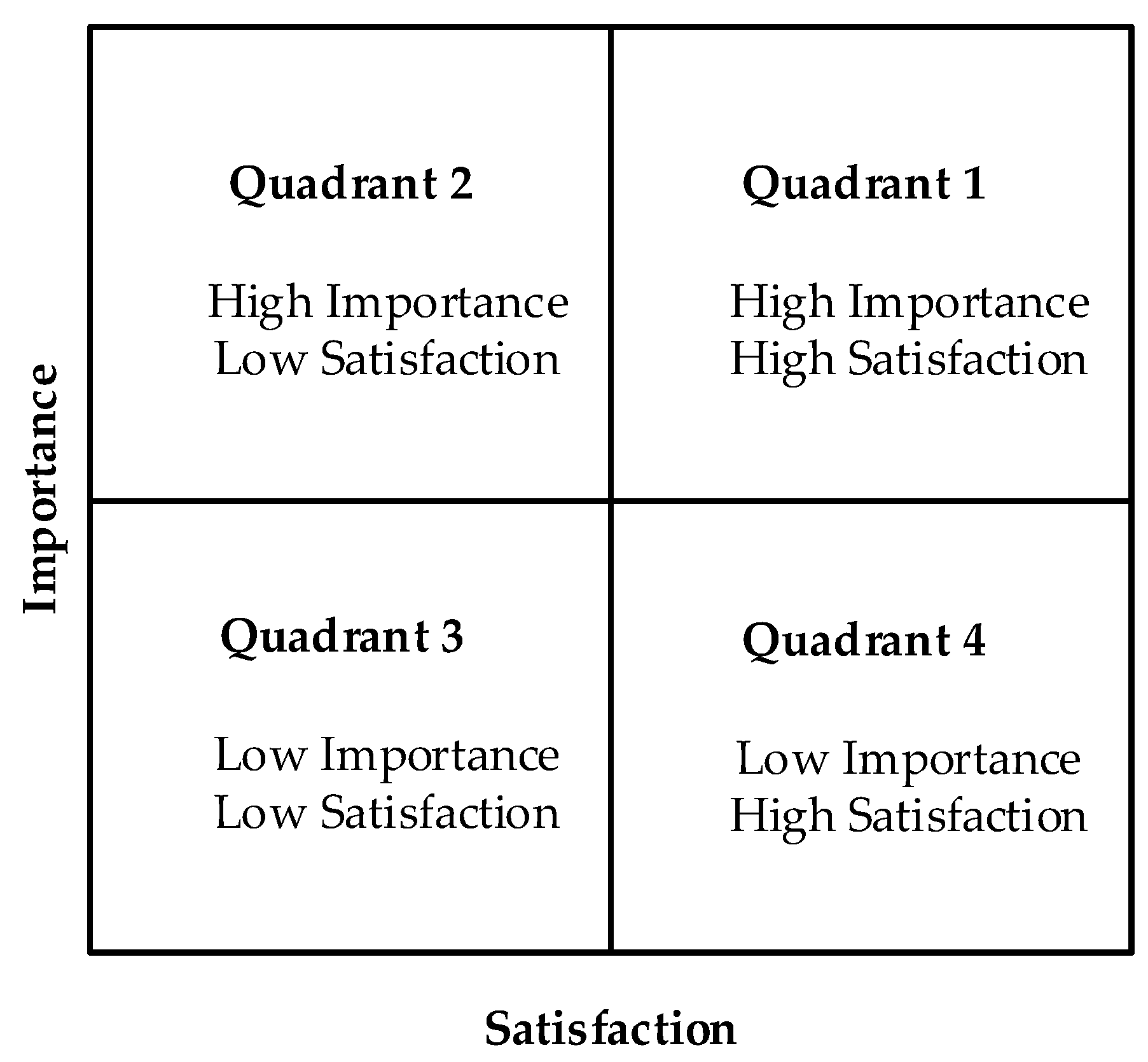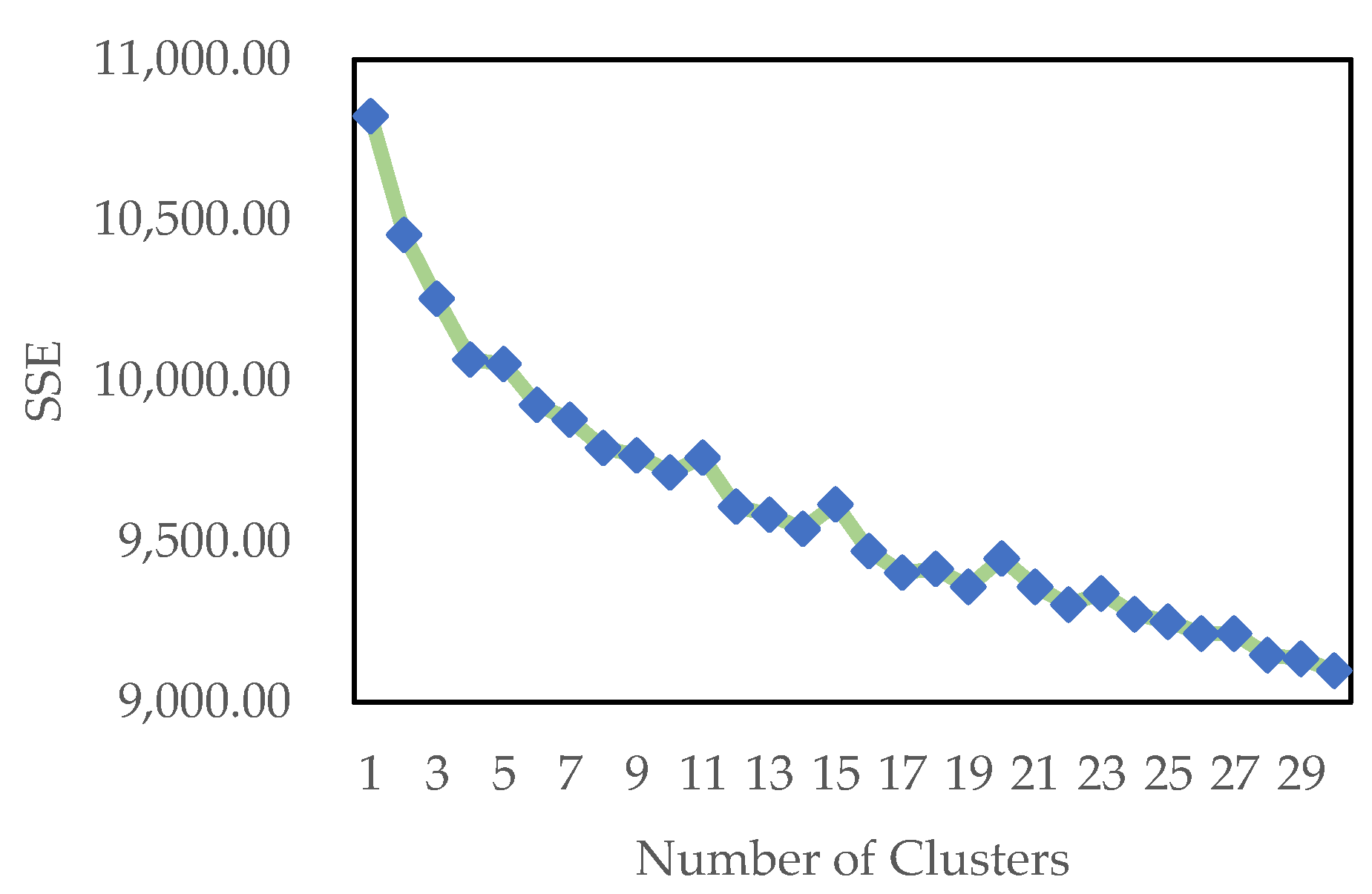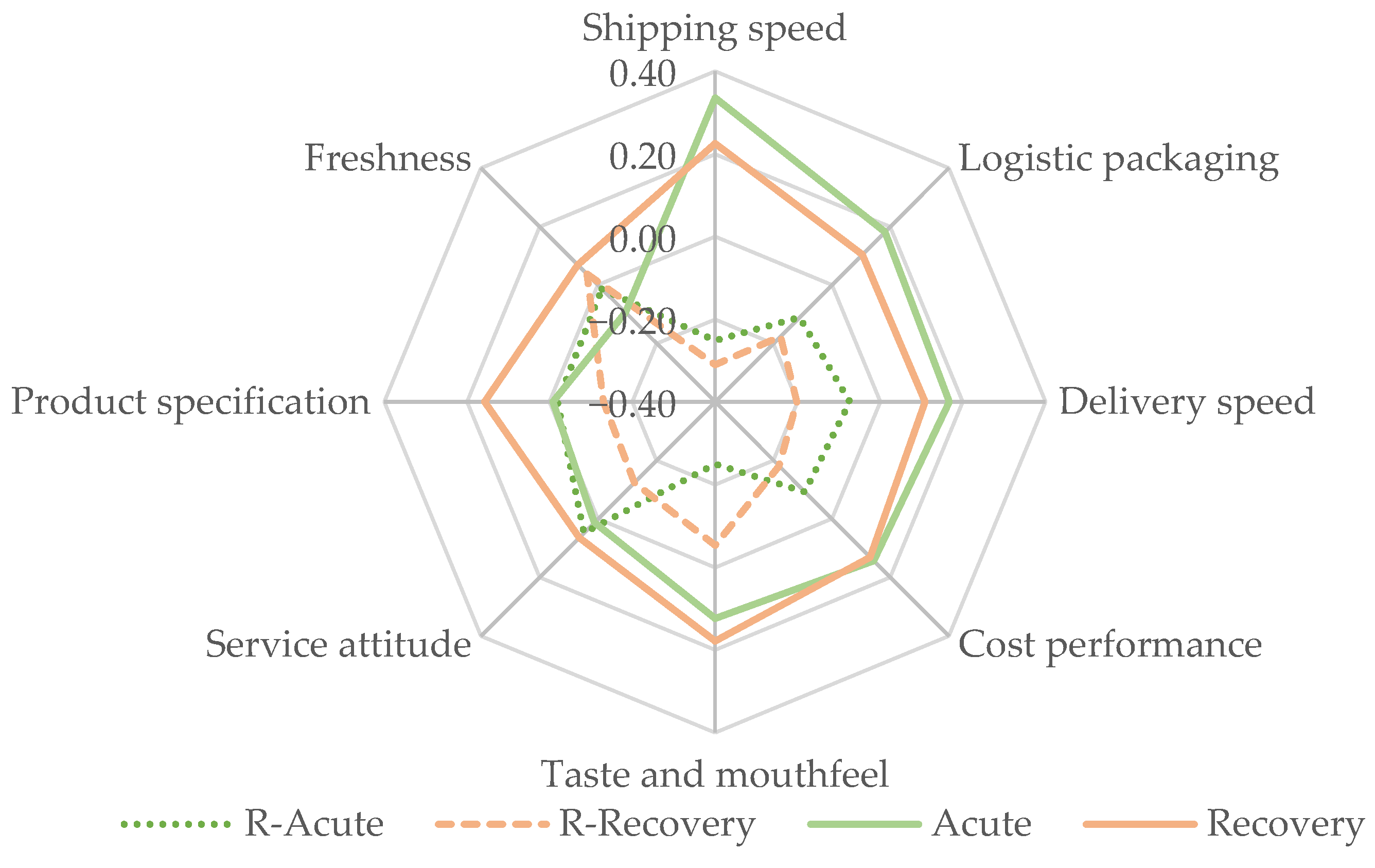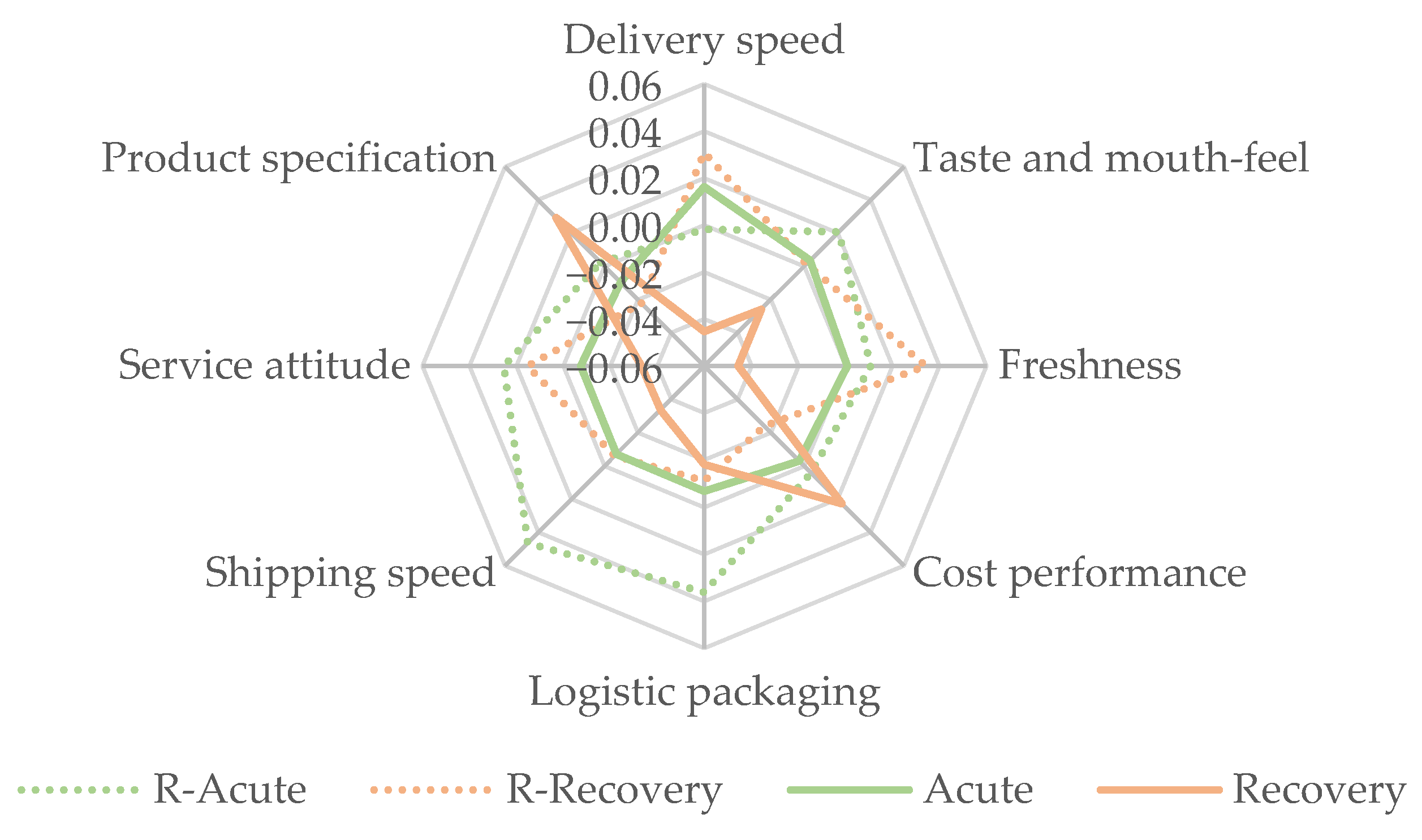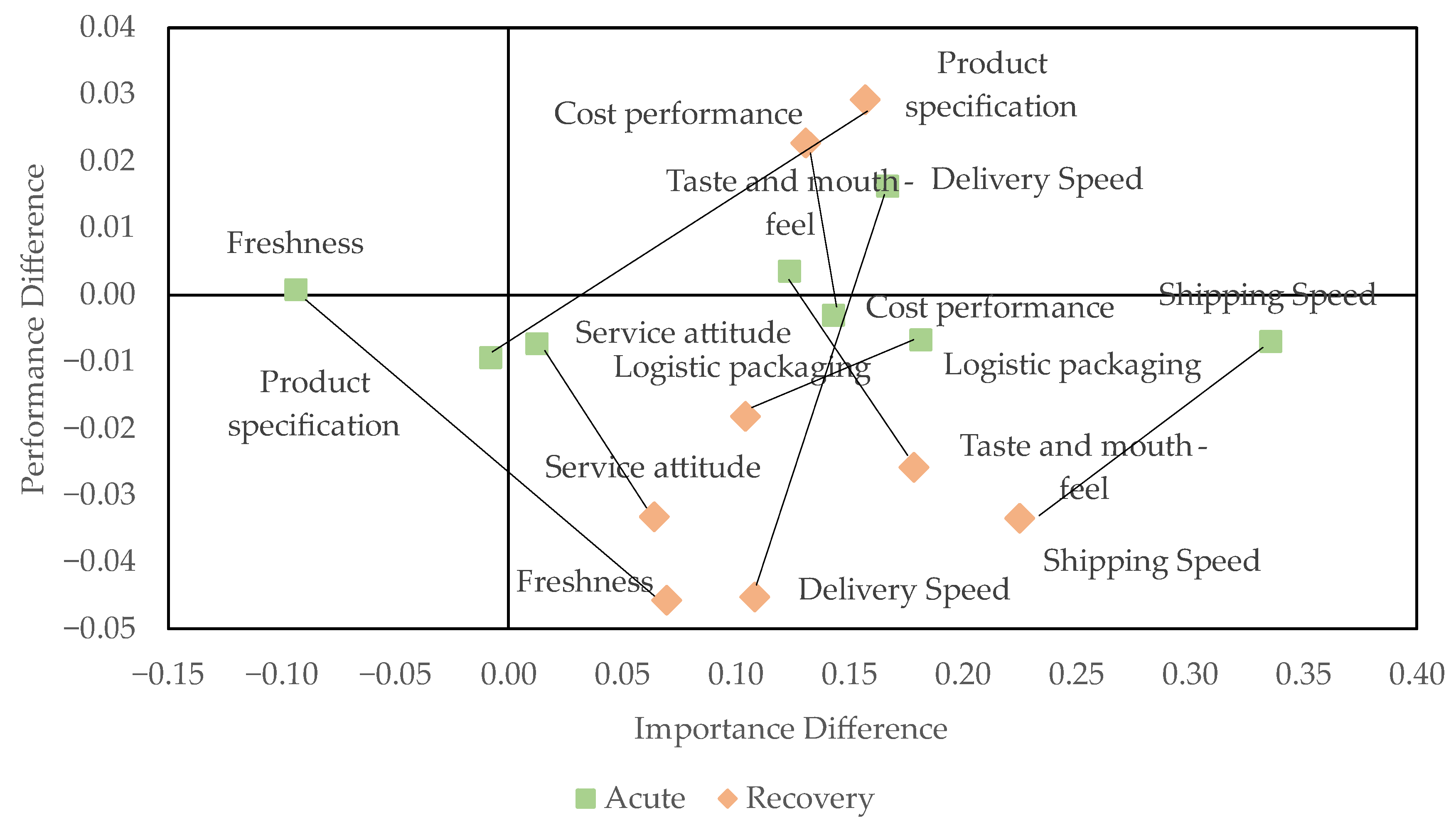1. Introduction
The outbreak of coronavirus disease 2019 (COVID-19) has had an impact on many areas. Many countries have taken measures, such as restricting entry, social distancing, and staying at home, to slow the diffusion of COVID-19 worldwide [
1]. Moreover, many industries have been badly affected, such as the hospitality business and logistics industry [
2]. However, social distancing and customer concerns about health and safety have contributed to the rapid growth of e-commerce [
3]. Non-face-to-face online consumption has become a significant consumption channel. During the pandemic, online consumption of fresh food has increased, and fresh food e-commerce has become more active. Every additional confirmed patient of COVID-19 increased transactions of fresh food e-commerce by 5.7% and the number of customers by 4.9% [
4]. Taking Shanghai as an example, in the first quarter of 2020, when the COVID-19 epidemic was severe, fresh food e-commerce saw sales increase by 167% year-on-year, and orders increased by 80% (
https://sww.sh.gov.cn/swdt/20200414/1137467adefb4ef6bd896d7f774884e8.html (accessed on 13 April 2020)).
In addition to increasing customers’ willingness to buy fresh food from e-commerce channels, the COVID-19 outbreak has also affected customers’ expectations and preferences [
5]. Fresh food e-commerce faces tremendous pressures to meet the evolving customer needs, which may influence customer satisfaction and finally make or break their business. Previous literature on the impact of COVID-19 on fresh food e-commerce studied the change in food prices during the pandemic situation [
6], customer demand, and customer consumption frequency for online fresh food during the pandemic [
4,
7,
8], the change in fresh food distribution and retail models owing to the COVID-19 outbreak [
9,
10], factors influencing the purchasing tendency of fresh food e-commerce customers [
11,
12,
13,
14,
15], and factors affecting customer satisfaction during the pandemic [
8,
16,
17].
In summary, the existing literature has conducted extensive research on the impact of COVID-19 on fresh food e-commerce. However, there are still gaps that need to be addressed. Few studies focused on the changes in customers’ opinions through comparative analysis of customers’ expectations and satisfaction before and during the pandemic, which is a crucial way to meet customer needs and improve customer satisfaction during a crisis. Existing studies often focus on the fresh food e-commerce sector during the pandemic, lacking comparative research and in-depth analyses on changes in consumer opinions at the product and service attribute levels. Therefore, the present study aims to reveal customers’ opinions change on fresh food e-commerce products and services before and during the pandemic to help fresh food e-commerce improve their customer satisfaction in the case of a crisis.
With the expansion of online shopping, online reviews, as a form of user-generated content posted by customers spontaneously, have become a significant source of data for assessing customer satisfaction [
18]. Online reviews help not only potential customers make purchase decisions [
19], but also managers identify factors affecting satisfaction [
20,
21,
22] and improving products or services [
23,
24,
25,
26]. In summary, online reviews are an effective way to understand customers. Therefore, online reviews are used in the present study to reveal changes in customers’ opinions. To this end, the following questions will be answered in this study:
- (1)
What are the attributes of fresh food e-commerce products and services that affect customers’ opinions?
- (2)
How can text mining of online reviews determine that the importance of attributes customers attach to fresh food e-commerce products and services have changed during the COVID-19 pandemic?
- (3)
Through attribute-level sentiment analysis, how did customers’ opinions change on the product–service performance of fresh food e-commerce during the COVID-19 pandemic?
- (4)
From the changes in the importance and customer satisfaction of product–service attributes, what enlightenment can be drawn from fresh food e-commerce to cope with the sudden pandemic?
This study makes three major contributions. First, utilizing online review-mining techniques and conducting comparative analysis before and during the pandemic, this study identified the varying customer attention and evaluation of product service attributes of fresh food e-commerce. It is based on online reviews and explores customer opinion changes at the attribute level across the different stages of COVID-19, enriching and expanding current research on e-commerce during COVID-19. Second, through the comparative importance–performance analysis (CIPA) model, this study offers strategies that fresh food e-commerce businesses can adopt in response to sudden pandemics to enhance operations and increase satisfaction. Third, the integrated text-mining methodology employed in this study can provide insights for analyzing customer opinion changes in other fields as well.
This study is further structured as follows.
Section 2 shows the literature review, and
Section 3 introduces the methodology, which contains data collection and preparation and specific research methods used in this study.
Section 4 analyzes the results of each research method and answers the above questions. Finally,
Section 5 concludes this study and discusses the academic contributions and managerial significance, including the limitations and future research.
4. Results
4.1. Attribute Identification
In this study, we utilized Python to implement TF-IDF, SVD, and K-means clustering analysis of the collected online reviews. The appropriate number of clusters of the K-means method is first selected according to the sum of the squares of errors in clusters (SSE). As shown in
Figure 4, after the number of clusters is 6, SSE drops more slowly with the increase in clusters. However, we tested other cluster numbers, from 6 to 19. The results show that when the number is less than 13, fewer attribute numbers can be analyzed through clustering results, while when the number is more than 13, only repeated attributes are added. Therefore, the appropriate number of clusters we choose is 13.
Table 2 presents the clustering results by setting the number of clusters to 13. The researchers named clusters according to the high-frequency words in each cluster. The first, ninth, and tenth clusters all describe freshness-related topics, so we grouped them into one attribute named freshness. The fifth cluster named returned customer, the sixth cluster named overall quality, and the eleventh cluster named epidemic are weakly associated with specific product or service attributes, so we deleted these three topics. Finally, eight attributes are obtained: freshness, shipping speed, product specifications, delivery speed, logistic packaging, service attitude, taste and mouthfeel, and cost performance. From these eight attributes, customers’ evaluation of fresh food e-commerce products and services includes logistic service, customer service, and the product itself. Shipping speed, delivery speed, and product packaging are logistic service-related attributes. Product specification, freshness, cost performance, and taste and mouthfeel are product-related attributes. Service attitude is a customer service-related attribute.
4.2. Changes in the Importance of Attributes
To obtain the importance changes in attributes, we first build the attribute dictionary.
Table 3 shows some attribute words. Second, according to Equation (2), the importance of attributes was calculated. The standardized results of importance are obtained according to Equation (8).
Appendix A,
Table 4, and
Table 5 show the number of grouped sentences of each attribute, the importance results of attributes, and standardized results of importance, respectively.
Table 4 shows that “taste and mouthfeel” is the most important attribute, which gained the most customer attention in all periods, maybe because the primary function of fresh food is to satisfy consumers’ taste buds. Shipping speed has the least importance, possibly because consumers were not as focused on this attribute before and after the pandemic. Moreover, the industry has an unwritten convention for shipping speed (i.e., shipping within 48 h).
Figure 5 visualizes the results of standardized importance to show the changes in attributes’ importance in the four time periods. The positive (negative) value of standardized importance means this attribute gained (lost) importance in a certain period. In
Figure 5, it can be seen that a significant difference exists in the change value of attributes’ importance.
Notably, the importance of freshness decreased in the acute period, indicating the customers’ loss of interest in this attribute due to a limited supply of goods due to the pandemic. Conversely, some attributes (e.g., delivery speed, logistic packaging, and taste and mouthfeel) gained importance during the pandemic. The importance of shipping speed and delivery speed has increased significantly, which may be caused by the lower logistic capacity than usual caused by government controls during the pandemic. Moreover, customers are paying more attention to this. The importance of logistic packaging has also increased, possibly because the integrity and hygiene of logistic packaging can reduce the probability of virus transmission, and customers have become more concerned during the pandemic.
Unexpectedly, all attributes gained importance during the recovery phase. However, the importance of logistic service-related attributes (shipping speed, logistic packaging, and delivery speed) decreased compared with the acute phase. The reason may be the recovering capacity caused by the eased government control and fewer cases during the recovery phase, which resulted in less concern for these attributes. Some product-related attributes (taste and mouthfeel, product specification, and freshness) have increased in importance compared with the acute phase. This result reflects that customers are starting to focus on the product itself, rather than some logistics (shipping speed, logistic packaging, and delivery speed).
4.3. Changes in Customers’ Performance Assessments
Customer satisfaction is used to investigate customers’ performance of fresh food e-commerce. The sentiment expressed by customers is obtained through the method in
Section 3.4.
Table 6 shows the sentiment analysis results. The values of customer satisfaction (attribute performance)
calculated in Equation (7) are shown in
Appendix B. We standardized the achieved attribute performance for comparison analysis and displayed the results of standardized customer satisfaction in
Table 7.
Figure 6 visualizes the significant changes in customers’ performance assessment over time according to the value of standardized customer satisfaction. A positive (negative) value of standardized customer satisfaction represents a more positive (negative) evaluation of a single attribute in a certain period, indicating an improvement (decline) in attribute performance.
In
Figure 6, the attribute performance difference (e.g., cost performance, packaging, and delivery speed) of pre-COVID-19 periods exhibit some seasonal effects, which impact customers’ performance assessment. The reason may be in the R-Recovery phase, compared with the R-Acute phase, the warmer weather made customers have higher requirements for these attributes. However, differences exist in customers’ performance evaluation of attributes during these periods.
In general, during the acute phase, the performance values that customers evaluated were close to the average over four periods. This case indicates that customers did not respond strongly to the performance of attributes and showed greater forgiveness on most attributes (e.g., delivery speed, taste and mouthfeel, and freshness) during the pandemic. Customers complained about some attributes (e.g., service attitude, shipping speed, and product specification) but to a lesser extent. The reason may be customers’ understanding of the difficulty in maintaining good performance in these attributes during the acute phase.
Attributes (e.g., logistics speed, taste and mouthfeel, delivery speed, and service attitude) that showed significant declines in performance evaluation during the recovery phase indicated that fresh food e-commerce was unable to meet customers’ expectations for these attributes. During the acute phase, customers can forgive or expect less of these poor performances, but customer discontent was displayed during the recovery phase. Logistics service-related attributes and product freshness received poor ratings, and customer expectations for these increased compared with the acute phase. Moreover, the product cost performance and specifications have been higher evaluations.
4.4. Product–Service Optimization for Crises
CIPA was conducted and shown in
Figure 7 to obtain management measures for product–service optimization during crises such as a public health emergency. In
Figure 7, customers’ evaluations of the attributes’ importance and performance during the two phases of the pandemic were compared by jointly analyzing the difference in importance and performance. The average importance and performance weights of each attribute of the four time periods serve as the reference according to Equations (8) and (9) [
63]. The acute and recovery phases are also compared in
Figure 7. The horizontal distance between two points of one attribute represents the change in importance of the two phases, and the vertical distance represents performance differences existing in the two pandemic phases.
Focusing on the acute period, service attitude, cost performance, logistic packaging, and shipping speed gained importance but lost customer satisfaction and were “critical factors” during the pandemic. This finding highlights customers’ acute need for these attributes, which fresh food e-commerce could not successfully address. Delivery speed and “taste and mouth-feel” were rated more positively and considered more important, making them appear to be “hot-spots” during the pandemic. The reason may be that the pandemic has severely affected logistics capacity and the availability of fresh food. Customers pay more attention to these attributes but have a higher tolerance for their performance. In addition, the efforts made by fresh food e-commerce in the logistic service can adapt to the changes in customer needs. Freshness was the pandemic’s “unneeded luxury” with decreased importance and increased performance. Fresh food e-commerce was able to improve their freshness to meet customer expectations during the pandemic, but customers considered this attribute less important. Freshness will not be a priority for improvement. Product specification was pandemic “crisis losers”, which lost importance and performance during the acute phase. Customers might have recognized and shown some forgiveness to the limitations of fresh food e-commerce to improve the product specification setting to meet customer requirements.
Significant differences exist regarding the attribute performance and importance between the acute and recovery phases. Several attributes (e.g., service attitude, freshness, delivery speed, shipping speed, and taste and mouthfeel) are moved down from the position of the acute period and were the “critical factor” of the recovery phase. This result indicates that e-commerce has not successfully adapted to the changing customer need for these attributes in the recovery period, or the high customers’ tolerance for service failure made by fresh e-commerce during the acute pandemic has been reduced. Fresh food e-commerce should strive to improve these attributes in the recovery phase. Freshness moved from “unneeded luxury” to “critical factors”. Fresh food e-commerce should allocate resources for freshness improvement for its increased importance and decreased performance. E-commerce has adjusted its product specification and cost performance attribute recovery during the recovery period and gained increased customer evaluation. Particularly, customer satisfaction with product specification increased, and this attribute moved from “crisis losers” to the “hot-spots” quadrant. This case exemplifies e-commerce successfully adapting to the changing customer need for product specification.
5. Discussions and Conclusions
Most prior research investigated the impact of the COVID-19 pandemic and provided suggestions for e-commerce managers or policymakers. The existing literature has attempted to understand customer purchase behavior on fresh food e-commerce products or services through surveys during COVID-19. However, few focus on the customer opinion change in fresh food e-commerce before and after the COVID-19 outbreak through online reviews. The current study investigated customer opinion changes before and during the COVID-19 pandemic to gain actionable insights for fresh food e-commerce managers. Online reviews provided a good source of data for understanding customer opinions. The findings of this study can assist in guiding fresh food e-commerce managers in allocating limited resources in the case of a sudden public health emergency and adapting to meet the ever-changing customer needs. This study has answered the four research questions.
First, regarding the product and service attributes of e-commerce that affect customers’ opinions, we find eight product–service attributes that customers commented on in the online reviews through the text mining technique, K-means clustering method integrated TF-IDF, and SVD. The attributes are freshness, shipping speed, product specifications, delivery speed, logistic packaging, service attitude, taste and mouthfeel, and cost performance. These attributes also reflect customers’ focus on logistics service, customer service, and products.
Second, regarding the changes in customers’ perceptions of the importance of each attribute, we find that during the acute phase of the pandemic, shipping speed, logistic packaging, and delivery speed related to the logistic service of e-commerce gained increased customer attention, which is consistent with the conclusions from previous studies [
16]. Moreover, product specification and freshness related to the product lost importance. However, during the recovery phase of the pandemic, compared with the acute phase, the importance of taste and mouthfeel, product specification, and freshness related to the product increased, and the importance of logistic service-related attributes, such as shipping speed, logistic packaging, and delivery speed, decreased. These results of the different attribute importance changes in the recovery phase compared with the acute phase extend previous research on consumer behavior regarding e-commerce in the background of COVID-19 [
15,
16,
29].
Third, regarding the changes in customers’ opinions on the product–service performance, we find that during the acute phase of the pandemic, customers show a greater level of forgiveness on many attributes, particularly for delivery speed, taste and mouthfeel, and freshness. Moreover, they evaluated the poor performance of the product–service attributes relatively positively. However, customer dissatisfaction toward logistic service-related attributes, customer service-related attributes, and freshness has been relatively fully expressed in the recovery phase of the pandemic. These findings also extend existing research. Previous studies have shown that COVID-19 has impacted customer experience or satisfaction in the fresh food e-commerce sector [
16] or general online consumer purchasing [
8,
15]. In contrast, the findings of this study provide a more detailed insight into how satisfaction levels change and vary across different attributes during COVID-19.
Last, regarding the enlightenment for fresh food e-commerce to cope with the sudden pandemic, we conducted CIPA to form practical strategies to guide them to optimize their product and services. For instance, owing to the suddenness of the pandemic and the government’s prevention and control measures, fresh food e-commerce needs to focus on and improve some attributes (e.g., cost performance, shipping speed, service attitude, and logistic packaging) during the pandemic, particularly the recovery phase, to achieve customer satisfaction.
5.1. Theoretical Implications
The theoretical implications of this study are mainly in the following two aspects. First, this study provides insights into customer perceptions regarding fresh food e-commerce. Through the use of text-mining techniques, this study identified eight key attributes that customers pay attention to and express their opinions on the logistic-related services, customer service, and the product itself. This study also found that among the eight attributes, “taste and mouth-feel” is the most important attribute, which gained the most customer attention in all periods, while shipping speed has the most minor importance.
Furthermore, this study delved into the changes in customer opinions at the attribute level, enriching and expanding the existing research on the ever-changing customer opinions of e-commerce. This study investigates the impact of the COVID-19 pandemic on fresh food e-commerce and compares the preferences and expectations to obtain customer opinion change before and during the pandemic. The findings of this study provide evidence that e-commerce customer opinions on product and service attributes can be changed due to the outbreak of acute pandemics, such as COVID-19 and the government’s prevention measures alter customers’ expectations for the products and services of fresh food e-commerce.
Finally, this study also found that during different stages of the pandemic, customer’s focus and expectations also exhibited varying changes. For example, during the acute phase of the COVID-19 pandemic, due to customer concerns about the outbreak, attributes related to logistics services became the focal point of customer attention. This can be attributed to customers prioritizing the swift delivery of products during the pandemic. However, as the situation gradually came under control and recovery began, customers shifted their focus to attributes associated with the product itself. Customers began to pay more attention to the quality of products as the pandemic subsided, with people gradually regaining their focus on their dietary health and quality of life. This finding provides valuable insights for future research on e-commerce during pandemics, as discussions on different pandemic stages appear to be necessary.
5.2. Practical Implications
This study also has implications for management practice. For fresh food e-commerce, this study can help guide fresh food e-commerce’s practice to prioritize its measures and adapt to possible changes in customer needs during pandemics through the results of CIPA. For instance, during the acute phase, the delivery speed gained more customer tolerance and was located in quadrant 1 as “good work”. Customer attention to freshness was reduced in this phase, but it gained importance and lost performance evaluations in the recovery stage. Fresh food e-commerce managers can reduce attention to these attributes during the acute stage of the pandemic but must improve these products and services during the recovery period to avoid a decrease in customer satisfaction.
Service attitude, logistic packaging, and shipping speed need to gain higher priority to focus and improve during the pandemic periods. Cost performance and product specification should gain high priority to improve during the acute phase of the pandemic, but customers’ performance evaluation increased during the recovery phase, indicating that customers’ requirements concerning this attribute may return to normal. Products or services related to these two attributes need to be improved as much as possible to meet the increased requirement during the acute stage of the pandemic and can be relaxed during the recovery period. Fresh food e-commerce can temporarily reduce efforts to maintain the freshness of products during the acute period. However, during the recovery phase, the maintenance of freshness must be focused on.
This study can also help consumers better understand their own needs and continuously adjust their expectations for fresh food e-commerce during future severe pandemics, thereby reducing unnecessary disputes and conflicts arising from dissatisfaction with products and services due to force majeure. This study also encourages customers to write reviews expressing their opinions, thereby providing convenience for managers to understand the evolving customer needs. For the government, supporting businesses in meeting consumer needs at different stages is crucial. The government can provide guidance and support for the e-commerce of fresh food, promoting the effective operation of the industry during both the acute phase and the recovery phase of an epidemic while ensuring consumer rights and satisfaction. For example, establishing a safe, hygienic, and efficient logistics and storage system can ensure logistics’ timeliness and products’ freshness during the epidemic recovery period.
5.3. Limitations and Future Research
This study presents several limitations. First, online reviews are typically written by customers who are highly positive or negative, and certain demographic groups are more inclined to write reviews. Therefore, the collected data may lean toward the viewpoints of this particular group of people. Meanwhile, customers may have different expectations for e-commerce providers of various types of fresh food during the epidemic period. The failure to segment customers in this paper may overlook subtle differences in customer opinions. Second, online reviews may contain invalid data, such as fake reviews or reviews manipulated by competitors. Therefore, the lack of filtering out invalid comments is also a limitation of this paper. Third, at present, there may be some evidence suggesting that the COVID-19 pandemic has come to an end. The conclusions of this paper may have limited practical implications for the current situation. However, the findings of this study can be utilized for future severe epidemic outbreaks and guide fresh food e-commerce and the government to improve relevant emergency plans for supplying fresh products during pandemic outbreaks.
Fourth, limited by e-commerce sites, the amount of data we can view and obtain is limited. The number of fresh food online reviews in 2019 was lower than that in 2020, which may be because of the impact on fresh food sales of the COVID-19 pandemic. Therefore, the number of online reviews collected for this study is also unevenly distributed between 2019 and 2020. Fifth, this study fails to subdivide fresh food e-commerce companies or categories. Customers’ expectations of enterprises with different companies and different types of products may be inconsistent. Finally, online reviews used in this study were collected from a single website.
Future research may integrate online reviews with methods such as questionnaires and interviews to obtain more representative conclusions and capture the differences in perspectives among different demographic groups based on statistical characteristics. The inconsistency in the evaluation of different customers, different companies, or product categories of fresh food e-commerce with different data sources may also be considered in future research. Future research may also develop models to filter out invalid reviews and improve data quality. From the initial outbreak of the epidemic to China lifting all control policies, the development of the epidemic has gone through other various stages. During these stages, there may be specific trends and patterns in the changes in customer opinions. Exploring these patterns will also be an important focus of future research.

